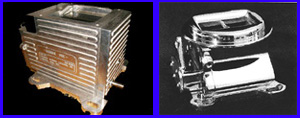

![]()

![]()
The following events are to the best of my recollection.
I first met Willard in 1973. My friend Larry had purchased a Kendig VVC. Larry had contacted Willard to see if he could fine tune the carburetor for him. So I went with Larry to Torrance where Willard did just that and fine tuned the carburetor to run on Larry's 1966 Ford 390.
This started a great friendship between Larry and Willard, and to a lesser extent between Willard and me.
Willard was a man of great practical knowledge whereby his considerable experience was put to use in solving the most complex problems in a concise, elegant and simple way. Where we saw a complication, he saw the solution. And this was for any problem at hand, not just carburetion.
He explained to us that day in 1973 that he had come up with the idea for the VVC in order to get away from Hilborn style fuel injection and all the associated expense and complication that came with balancing such an induction system.
Willard was well aware that the VVC would not start a cold engine easily. He said that he had invented the VVC for racing purposes only. He indicated that it was a recent development (in 1972 or so) that it was decided to market the VVC for street use. Willard said that just like you had to start so many of the race cars of that day with a squirt can full of fuel, that that was how he intended the VVC to be started.
Interestingly though, when we were there at the Torrance shop, Willard was working on a very unique enrichment system for the VVC. It was a fuel circuit that was simple in design and eliminated a great deal of mechanical complication. Here again, simple being a trademark for Willard. In the world of mechanical systems, making something simple can be one of the hardest and most complicated things to do. A seeming paradox that Willard was uniquely qualified to accomplish.
Setting on a work bench was one solution for the cold startup problem. Willard had embraced and actually had built this experimental VVC. It was a VVC with a Ford style accelerator pump grafted onto the main body. It was not there for any other reason than to provide the enrichment needed to start a cold engine. He said the extra shot of fuel that was pumped every time the throttle was moved was not needed at all once the engine was warm. He rejected this accelerator pump idea deeming it too gross and complicated.
I think this prototype unit can be seen somewhat in the photo of the Boss 429 and Chevy 350 engines. It is lying on its side on the bench directly above the 350 Chevy engine.
This particular prototype could possibly be seen by some as what later became the Predator Carburetor. If you look at a Predator carburetor, the Ford style accelerator pump stands out prominently. The Kendig VVC predates the Predator. You be the judge and draw your own conclusions here.
I later obtained a Kendig VVC for myself to run on my 427 BB 56 Chevy. It did have the start up problem as described above, but once warmed up, the engine pulled a lot harder from 2000 to 6000 RPM and the car accelerated much faster with a very smooth and continuous run up to top speed. (Top speed in a 56 Chevy is limited and scary.) This was the single biggest bolt on gain I had ever experienced with this car.
Willard was not satisfied with this VVC design. It was not doing what was needed in order to be an efficient street style carburetor.
What he developed next was truly astounding. Unfortunately this new unit was never brought to market. It was designed and prototyped, but only this one unit existed.
Willard first told Larry and me of this unit when he drew it out in the dirt for us at his farm in Yettem, CA.
Willard called his new unit "Sonic Fuel Injection". If you called it a carburetor, he would quickly correct you.
It was totally mechanical involving no electronics whatsoever and of course it was sophisticatedly "simple".
It flowed somewhere around 1000 CFM. It was shorter in height than the VVC. It could be run in any position, even upside down! It required only 7psi or less of inlet fuel pressure. And, it had no start up problems. It holds a USA patent.
Willard found that it could take a stock 1974 350 Chevy V8 Malibu from 15 MPG to somewhere near 44 MPG and at the same time dramatically increase overall performance. These results were obtained using the first and only prototype unit.
It's a shame Willard never got to manufacture the sonic fuel injection system. (It would have fit easily under the hood of my own 1972 Corvette.) It seems to me that even today there would be a market for such a unique system.
There are numerous stories associated with Willard and his mechanical exploits. He was truly a unique individual. If we only had more people like him now, the USA would be a better place indeed.
Willard died on May 4, 2011 at the age of 91 and was buried in Fresno on May 13, 2011 with full military honors.
Thanks for your interest.
Terry
![]()